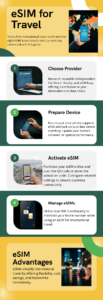Traveling abroad can be an exciting and enriching experience, but it often comes with the challenge of staying connected. Traditional SIM cards are normally not so easy to handle and are expensive, they often have very poor coverage.
This is where eSIMs come in. An eSIM has much more flexibility in approaching and helping with less hassle-all international travelers with their connectivity needs.
Learn how to set up your eSIM for the next holiday right here, stay connected, and save money in the process for a hassle-free journey.
1. Choosing the Right eSIM Provider
The secret of a seamless international trip lies in choosing the right eSIM provider since there is no need to change physical SIM cards. More than 190 countries are now within coverage by eSIM technology, hence an excellent solution for travelers.
Get a plan that fits your data and travel needs, whether it is HD streaming or just simple browsing. You need to be careful in choosing when it comes to eSIM setup through reliability and cost-effectiveness, it has to keep you connected no matter what.
Consider Plan Options
Your usage habits can be as different as chalk and cheese, again justifying relevance for the act of making a plan that shall fit your needs. In an hour, for instance, HD video streaming appears to use as much as 4 GB, with simple browsing and emails using a few hundred MBs a day. Get eSIM plans that have flexible data allowances and validity so you don’t run out while on the go.
Check for Special Offers
Sure, there are a lot of promos and discounts that eSIM providers present to new subscribers or to those who remain for an extended period out of the country.
2. Preparing Your Device for eSIM
Prepare your device before installing the eSIM Feature for a Foreign trip. Smartphones, including those from Apple, Samsung, and Google, support this feature, making it widely accessible. However, it’s crucial to verify compatibility with your device’s manufacturer or your eSIM provider. If migrating from a physical SIM, backup your contacts, messages, and other critical data so that you do not lose data.
Preparing your device before starting your travel is a necessary step to be followed before traveling to other continents. If you plan to visit any European country, it’s important to ready your device for seamless eSIM use. With everything in place, you can enjoy a stress-free experience using the best esim for europe.
Device Compatibility
Most of the modern smartphone devices that are launched, including best-seller devices from Apple, Samsung, and Google, support eSIM functions. Be sure to check with your manufacturer specifications or eSIM provider for compatibility.
Backup Your Existing SIM
If you’re migrating from a physical SIM card to an eSIM, don’t forget to back up all the contacts, messages, and other valued data you’ve saved onto your device, otherwise, this will be lost in the process. Set this up either through your device’s native backup or via a third-party application.
Download Necessary Software Updates
Ensure your OS is updated, as many updates include important features and fixes aimed at maximizing eSIM functionality.

3. Purchasing and Activating Your eSIM
The purchasing process is generally straightforward, as most vendors provide an online option and email a QR code for easy activation. This eSIM makes the process very easy to install and for tourists to quickly get connected.
Activation Steps
- Go to your device’s “Cellular” or “Mobile Data” settings.
- Select “Add Cellular Plan” and scan the QR code or enter the activation code provided by your eSIM provider.
- Confirm the activation and select the eSIM plan as your primary or secondary line, depending on your needs.
Configure Network Settings
Properly configuring your network settings will allow easy connectivity and also avoid unexpected roaming charges while using your phone abroad. That includes setting the eSIM as the default line for data, turning on roaming if needed, and setting whatever else may need it.
4. Managing Multiple eSIMs
Using Dual SIM Functionality
Most of these new smartphones have dual SIMs. This simply means you can still retain your number for home but use an eSIM when going abroad. That is particularly useful when one travels on business or for people who like to keep all their domestic contacts separate from international ones.
Switching Between eSIMs
With this technology, multiple eSIM profiles can be practically put onto a device. This flexibility allows connections to be kept running yet SIM cards do not physically need to be changed at each point, making it a walk in the park while navigating across several countries.
5. Troubleshooting Common eSIM Issues
Connectivity Problems
In case it does not connect to a local network, restart your device, reset network settings, and check that roaming is on. If this does not help, please contact the eSIM service or the customer support of your carrier.
Data Limitations
Monitoring your data usage can help avoid unexpected overage charges. This is much more critical in cases when one is streaming or using data-intensive applications.
Customer Support
Accessing customer support from your eSIM provider while traveling can be a lifesaver if you encounter any issues. Familiarize yourself with their support channels, including phone, email, and in-app assistance, to ensure you can get help quickly, even in different time zones.
Conclusion
With an eSIM, one will be able to set up an account to travel to almost every country with seamless and cost-effective options, without the hassle of SIM cards. With its right provision, preparation of the device, and management of multiple eSIMs, there will be ease of operation across various countries.
Support services will resolve all glitches and make the whole experience hassle-free, letting one be absorbed in the moment of traveling. This positions you in such a way that your travel shall be smooth, with flexibility and convenience provided by the eSIM technology.
Frequently Asked Questions
- Can I use an eSIM and a physical SIM simultaneously on my device?
Yes, most modern smartphones support dual SIM functionality, allowing you to use both an eSIM and a physical SIM at the same time. This is particularly useful for maintaining your home number while using the eSIM for international data.
- What happens if I lose my phone with an activated eSIM?
If your phone is lost, contact your eSIM provider immediately to deactivate the eSIM remotely. You can also transfer your eSIM to a new device by logging into your account with the provider and following their transfer process.
- How do I ensure that my eSIM will work in the country I’m visiting?
Research your destination’s mobile network compatibility with your eSIM provider. Ensure your device is unlocked and supports the frequency bands used in the country you’re visiting.
- Can I use my eSIM in multiple countries during a single trip?
Yes, one of the key benefits of eSIMs is the ability to easily switch between different plans or profiles, allowing you to manage your connectivity as you travel to various destinations.
- Are there any hidden fees or roaming charges with eSIMs?
Reputable eSIM providers generally offer transparent pricing and aim to minimize hidden fees or roaming charges. However, it’s always a good idea to review the plan details and terms and conditions to understand any potential additional costs.



